 |  | |
| HomePrev | Part XIII. Web Client Preview | Next |
|---|
Table of Contents
Use this section for understanding the circulation procedures in the Evergreen system.
1) To check out an item click Check Out Items from the Circulation and Patrons toolbar, or select Circulation → Check Out.
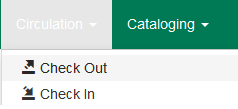
2) Scan or enter patron’s barcode and click Submit if entering barcode manually. If scanning, number is submitted automatically.

3) Scan or enter item barcode manually, clicking Submit if manual.

4) Due date is now displayed.

5) When all items are scanned, click the Done button to generate slip receipt or to exit patron record if not printing slip receipts.
1) Go to patron’s Check Out screen by clicking Circulation → Check Out Items.
2) Scan the item barcode.
3) At prompt, enter the required information click Precat Checkout.
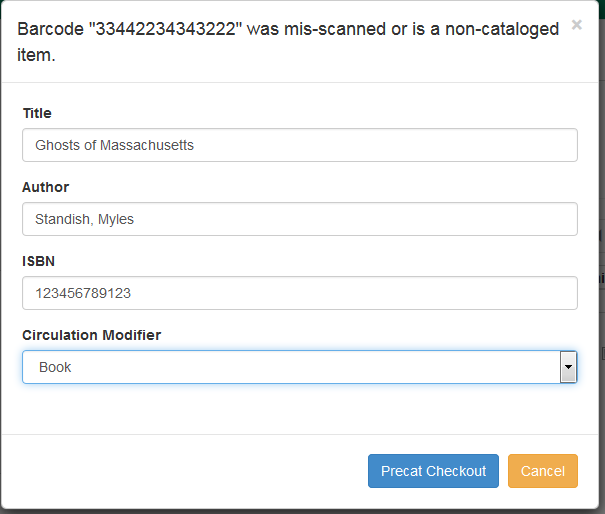
On check-in, Evergreen will prompt staff to re-route the item to cataloging.
Circulation periods are pre-set. When items are checked out, due dates are automatically calculated and inserted into circulation records if the Specific Due Date checkbox is not selected on the Check Out screen. The Specific Due Date checkbox allows you to set a different due date to override the pre-set loan period.
Before you scan the item, select the Specific Due Date checkbox. Enter the date in yyyy-mm-dd format. This date applies to all items until you change the date, de-select the Specific Due Date checkbox, or quit the patron record.

1) To check in an item click Check In Items from the Circulation and Patrons toolbar, or select Circulation → Check In.
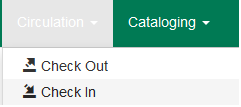
2) Scan item barcode or enter manually and click Submit.

3) If there is an overdue fine associated with the checkin, an alert will appear at the top of the screen with a fine tally for the current checkin session. To immediately handle fine payment, click the alert to jump to the patron’s bill record.

This is useful for clearing a book drop.
1) To change effective check-in date, select Circulation → Check In Items. In Effective Date field enter the date in yyyy-mm-dd format.

2) The new effective date is now displayed in the red bar above the Barcode field.

3) Move the cursor to the Barcode field. Scan the items. When finishing backdated check-in, change the Effective Date back to today’s date.
After an item has been checked in, you may use the Backdate Post-Checkin function to backdate the check-in date.
1) Select the item on the Check In screen, click Actions → Backdate Post-Checkin.

2) In Effective Date field enter the date in yyyy-mm-dd format. The check-in date will be adjusted according to the new effective check-in date.

Checkin Modifiers
At the right bottom corner there is a Checkin Modifiers pop-up list. The options are:
-Ignore Pre-cat Items: no prompt when checking in a pre-cat item. Item will be routed to Cataloguing with Cataloguing status.
-Supress Holds and Transit: item will not be used to fill holds or sent in transit. Item has Reshelving status.
-Amnesty Mode/Forgive Fines: overdue fines will be voided if already created or not be inserted if not yet created (e.g. hourly loans).
-Auto-Print Hold and Transit Slips: slips will be automatically printed without prompt for confirmation.
-Clear Holds Shelf. Checking in hold-shelf-expired items will clear the items from the hold shelf (holds to be cancelled).
-Retarget Local Holds. When checking in in process items that are owned by the library, attempt to find a local hold to retarget. This is intended to help with proper targeting of newly-catalogued items.
-Retarget All Statuses. Similar to Retarget Local Holds, this modifier will attempt to find a local hold to retarget, regardless of the status of the item being checked in. This modifier must be used in conjunction with the Retarget Local Holds modifier.
-Capture Local Holds as Transits. With this checkin modifier, any local holds will be given an in transit status instead of on holds shelf. The intent is to stop the system from sending holds notifications before the item is ready to be placed on the holds shelf and item will have a status of in-transit until checked in again. If you wish to simply delay notification and allow time for staff to process item to holds shelf, you may wish to use the Hold Shelf Status Delay setting in Library Settings Editor instead. See Local Administration section for more information.
These options may be selected simultaneously. The selected option is displayed in the header area.
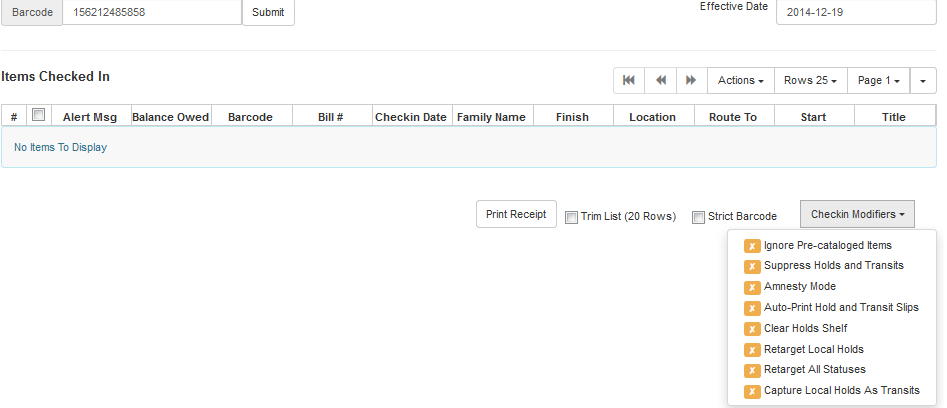
Checked-out items can be renewed if your library’s policy allows it. The new due date is calculated from the renewal date. Existing loans can also be extended to a specific date by editing the due date or renewing with a specific due date.
1) Retrieve the patron record and go to the Items Out screen.

2) Select the item you want to renew. Click on Actions → Renew. If you want to renew all items in the account, click Renew All instead.
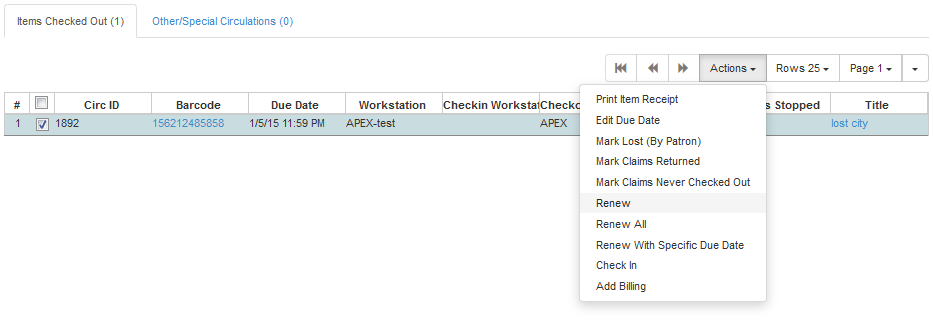
3) If you want to specify the due date, click Renew with Specific Due Date. You will be prompted to select a due date. Once done, click Apply.

1) To renew items by barcode, select Circulation → Renew Items.
2) Scan or manually entire the item barcode.

3) If you want to specify the due date, click Specific Due Date and enter a new due date in yyyy-mm-dd format.

1) To mark items Lost, retrieve patron record and click Items Out.
2) Select the item. Click on Actions → Mark Lost (by Patron).

3) The lost item now displays as lost in the Items Checked Out section of the patron record.

4) The lost item also adds to the count of Lost items in the patron summary on the left (or top) of the screen.
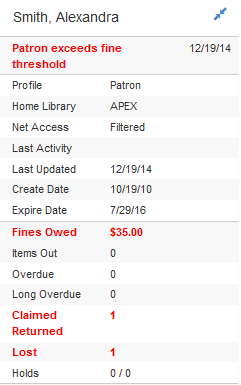
Lost Item Billing
If an item is returned after a lost bill has been paid and the library’s policy is to void the replacement fee for lost-then-returned items, there will be a negative balance in the bill. A refund needs to be made to close the bill and the circulation record. Once the outstanding amount has been refunded, the bill and circulation record will be closed and the item will disappear from the Items Out screen.
If you need to balance a bill with a negative amount, you need to add two dummy bills to the existing bills. The first one can be of any amount (e.g. $0.01), while the second should be of the absolute value of the negative amount. Then you need to void the first dummy bill. The reason for using a dummy bill is that Evergreen will check and close the circulation record only when payment is applied or bills are voided.
1) To mark an item Claimed Returned, retrieve the patron record and go to the Items Out screen.
2) Select the item, then select Actions → Mark Claimed Returned from the dropdown menu.

3) Enter date in yyyy-mm-dd format and click Submit.

4) The Claimed Returned item now displays in the Other/Special Circulations section of the patron record.

5) The Claimed Returned item adds to the count of items that are Claimed Returned in the patron summary on the left (or top) of the screen. It also adds to the total Other/Special Circulations that is displayed when editing the patron’s record.

More on Claimed Returned Items
1) To record in-house use, select Circulation → Record In-House Use.
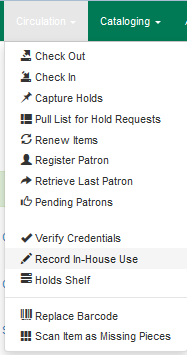
2) To record in-house use for cataloged items, enter number of uses, scan barcode or type barcode and click Submit.

The statistics of in-house use are separated from circulation statistics. The in-house use count of cataloged items is not included in the items' total use count.
The Item Status screen is very useful. Many actions can be taken by either circulation staff or catalogers on this screen. Here we will cover some circulation-related functions, namely checking item status, viewing past circulations, inserting item alert messages, marking items missing or damaged, etc.
1) To check the status of an item, select Search → Search for copies by Barcode.
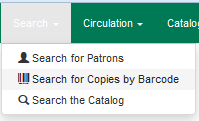
2) Scan the barcode or type it and click Submit. The current status of the item is displayed with selected other fields. You can use the column picker to select more fields to view.

3) Click the Detail View button and the item summary and circulation history will be displayed.
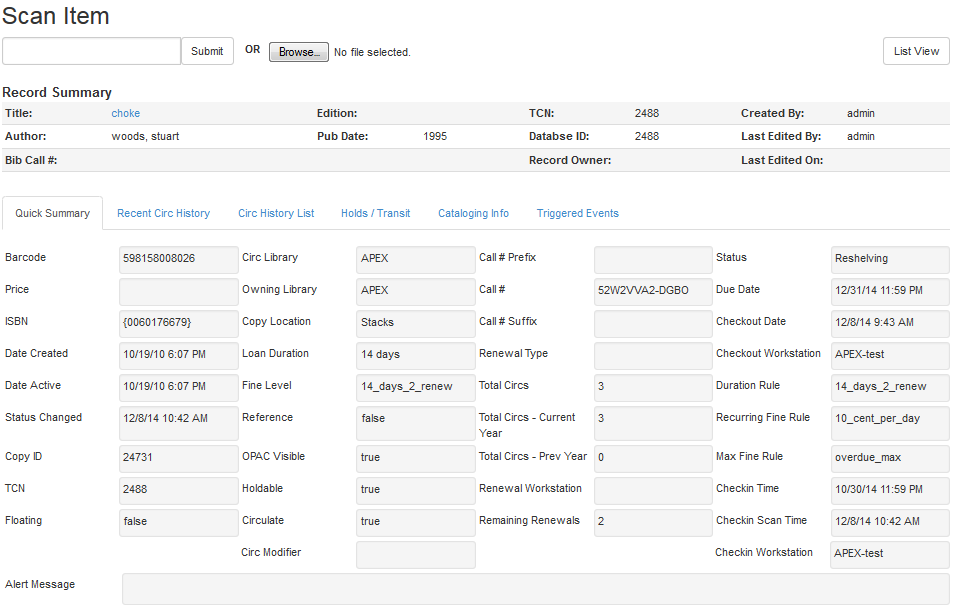
4) Click List View to go back.

If the item’s status is "Available", the displayed due date refers to the previous circulation’s due date.
Upload From File allows you to load multiple items saved in a file on your local computer. The file contains a list of the barcodes in text format. To ensure smooth uploading and further processing on the items, it is recommended that the list contains no more than 100 items.
1) To view past circulations, retrieve the item on the Item Status screen as described above.
2) Select Detail view.

3) Choose Recent Circ History. The item’s recent circulation history is displayed.
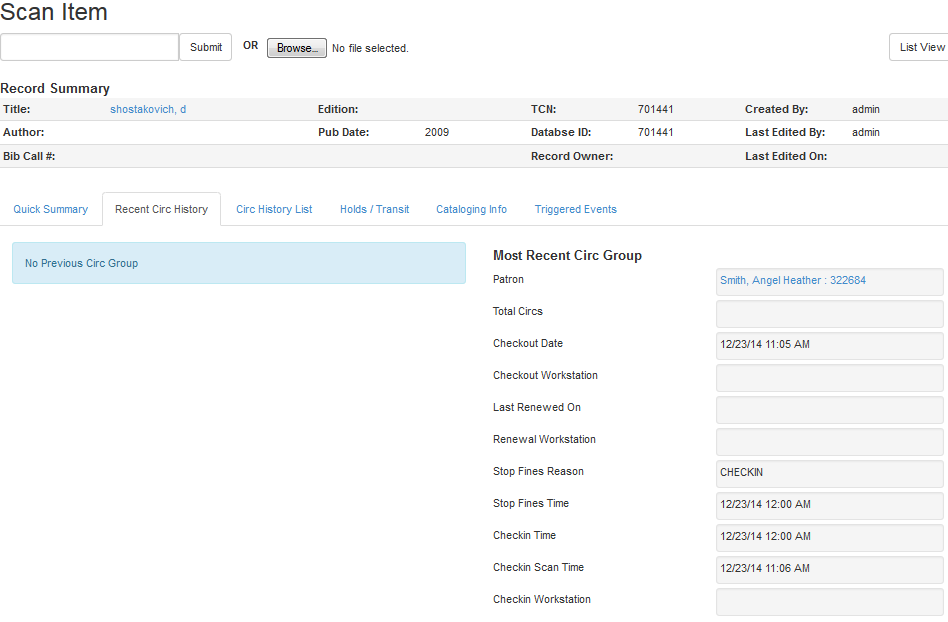
4) To retrieve the patron(s) of the last circulations, click on the name of the patron. The patron record will be displayed.
The number of items that displays in the circulation history can be set in Local Administration → Library Settings Editor.
You can also retrieve the past circulations on the patron’s Items Out screen and from the Check In screen.
1) To mark items damaged or missing, retrieve the item on the Item Status screen.
2) Select the item. Click on Actions for Selected Items → Mark Item Damaged or Mark Item Missing.

Depending on the library’s policy, when marking an item damaged, bills (cost and/or processing fee) may be inserted into the last borrower’s account.
3) Following the above procedure, you can check in and renew items by using the Check in Items and Renew Items on the dropdown menu.
The Edit Item Attributes function on the Actions for Selected Items dropdown list allows you to edit item records. Here, we will show you how to insert item alert messages by this function. See cataloging instructions for more information on item editing. 1) Retrieve record on Item Status screen.
2) Once item is displayed, highlight it and select Actions for Selected Items → Edit Item Attributes.
3) The item record is displayed in the Copy Editor.

4) Click Alert Message in the Miscellaneous column. The background color of the box changes. Type in the message then click Apply.

5) Click Modify Copies, then confirm the action.
Marking an item Long Overdue
Once an item has been overdue for a configurable amount of time, Evergreen will mark the item long overdue in the borrowing patron’s account. This will be done automatically through a Notification/Action Trigger. When the item is marked long overdue, several actions will take place:
Optionally the patron can be billed for the item price, a long overdue processing fee, and any overdue fines can be voided from the account. Patrons can also be sent a notification that the item was marked long overdue.
Checking in a Long Overdue item
If an item that has been marked long overdue is checked in, an alert will appear on the screen informing the staff member that the item was long overdue. Once checked in, the item will go into the status of “In process”. Optionally, the item price and long overdue processing fee can be voided and overdue fines can be reinstated on the patron’s account. If the item is checked in at a library other than its home library, a library setting controls whether the item can immediately fill a hold or circulate, or if it needs to be sent to its home library for processing.
Notification/Action Triggers
Evergreen has two sample Notification/Action Triggers that are related to marking items long overdue. The sample triggers are configured for 6 months. These triggers can be configured for any amount of time according to library policy and will need to be activated for use.
Sample Triggers
Library Settings
The following Library Settings enable you to set preferences related to long overdue items:
Permissions to use this Feature
The following permissions are related to this feature:
COPY_STATUS_LONG_OVERDUE.override